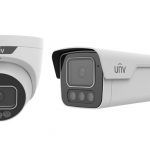Cloud Based License Plate Recognition Gains Traction With Niche Applications

As network connectivity and bandwidth availability continue to improve, the use of cloud is becoming more and more popular. Cloud-based solutions have made inroads into the day to day life of most people, right from the personal level in the form of emails to video surveillance footage.
Izvor: a&s International
E-mail: redakcija@asadria.com
Storing surveillance camera footage on the cloud allows you to run several analytic applications on them without having to worry about space and additional infrastructure. A solution that is increasingly gaining market interest in this regard is cloud-based ANPR solutions.
In this article, we explain the benefits and limitations of cloud-based ANPR solutions, along with their applica- tions, especially in intelligent transport systems.
What are the benefits of Cloud-Based ANPR Solutions?
The main difference between on-site and cloud-based ANPR solutions is where image processing takes place, according to Adrian Cseko, Head of Sales at Asura Technologies. In the case of cloud processing, the user sends data to the ANPR provider’s cloud, and results are returned to the specified database or system.
“Thus, the advantage of cloud-based solutions is that the client does not have to purchase a server and set it up on-site to run ANPR software,” Cseko said. “Moreover, most cloud-based solutions can be accessed in a subscription-type model, sometimes the pricing adjusted with processing volume. So, if avoiding CAPEX is the aim of a project, or there is simply no space to accommodate a server, a cloud-based ANPR solution may prove more beneficial. Also, as fewer elements are needed to be installed on-site, an ANPR-based operation may roll-out out earlier if a cloud-based solution is used.”
The Key Two-Fold Advantage
Evidently, there are several advantages to using cloud-based ANPR solutions. According to Gabor Jozsa, CMO at Adaptive Recognition, these can be classified under technology and cost. Jozsa listed some of the significant benefits under both these categories from the perspective of the solution that their company offers.
Cost Advantages
• Zero capital investment required.
• 50-60 percent Total Cost of Ownership reduction compared to on-premise systems.
• 3-4 times shorter implementation- and integration time.
• Start to recognize your own images in just 1 second after registration. Build your application around ANPR Cloud within one day. Start generating revenue in just days.
• Transparent and flexible pricing perfectly matches to every application.
• Adaptive Recognition’s ANPR Cloud offers credit-based, pay-as-you-go pricing packages.
• Minimal to zero OpEx: core engine updates, preventing maintenance, API updates are done by Adaptive Recognition. 99.9 percent SLA level secured worldwide, in all regions.
• Thanks to pay-per-use pricing, the actual cost of service is equivalent to practical use. There is no burden due to flat rates when the required service is low. You can recognize 1 million events at once and pay only for that. Then you may recognize 10,000 in the following months. You will always pay based on the service used.
Technological Advantages
• Integrators can finally focus on application functionality instead of setting up and operating an on-premises infrastructure.
• Easy to use REST APIs results are in JSON format.
• Anyone can become an ANPR expert. Simply upload your still images to Adaptive Recognition’s ANPR Cloud. The rest is done by the service, which tweaks the OCR engine’s internal parameters for the best results.
• ANPR Cloud is elastic, offers an unlimited scale. It is robust and stable.
• ANPR Cloud offers practically unlimited processing resources compared to on-premise, PC / server-based systems. This gives you a real competitive edge, mainly when you feed input images from all around the world. Specific OCR engines that yield the best result for one region can be run parallel in the ANPR Cloud, while this would require expensive and complex on-premises architecture.
How to Get These Benefits?
But cloud-based ANPR may not be suitable for every installation. According to Walter Verbruggen, Sales Director at Avutech Computer Vision, a cloud solution is ideal for a single, existing camera somewhere in the field, streaming video to the cloud ANPR service. It does need some thinking about: what do you want to do with the ANPR data?
“In case a smart security management system would send packets of snapshot images to the cloud, network bandwidth (and costs) can dramati- cally being saved,” Verbuggen said. “Cloud benefits in general: no local server to maintain or support, monthly subscription-based.”
Is a Cloud-Based ANPR Solution Suited to Your Business?
Cloud-based processing is ideal where the return-time of results is not a crucial point, e.g., when gathering traffic information or registering vehicles in a barrierless access control project. This means that if you want immediate results based on the ANPR reading, like opening a gate or raising a boom barrier, an edge-based solution may work best. But there are several verticals where such applications are not required, and this is where cloud-based ANPR is more useful. Here’s an overview of the major verticals that would benefit from cloud ANPR. Please note that this is not a comprehensive list, as the continuous development in technology enables more and more verticals to use cloud- based ANPR.
1. Intelligent Transportation Systems (ITS)
An intelligent transportation system (ITS) allows authorities to automate the process of managing traffic in a city to make it smarter and more efficient. ANPR has a vital role to play in ITS, especially in controlling over speeding and role rules compliance. Since these applications don’t require immediate action taken based on the plate reading, a cloud-based infrastructure that minimizes the investment on the camera side may be ideal.
2. Tolls for Motorways, Turnpikes, and Bridges
If your business involves toll collection on motorways, bridges, etc., without the use of a barrier, then a cloud-based ANPR may be suitable. This is because even as the vehicles pass through toll gates, payments can be triggered from an ANPR reading that is processed on the cloud. Such a system would help avoid unnecessary lines or crowding at toll gates and speed up the system. This may also come in handy in places where congestion charges are applicable.
3. Parking With Pay-by-Plate Services
If you provide gated parking space services, customers can make payments to use your parking space using wallets that are attached to their number plates. An ANPR solution that detects the plate can trigger the payment from wallets that may be connected to license plates. This may also be suited for other businesses like a car wash and vehicle servicing.
4. Mobile Patrols and Law Enforcement
Law enforcement officers may need to search for stolen vehicles or criminals fleeing in cars based on a number plate. In such situations, the system needs to search within video footage from multiple cameras. A cloud- based solution enables this as it is not limited to independent cameras. This application would come in useful at public facilities, shopping mall parking lots, campuses, etc.
5. Personalized OOH Advertising
A cloud-based ANPR solution can aid businesses in providing tailored services to customers. Based on the reading of a license plate, the system can recognize the customer, which in turn automates the customization process. An excellent example of this application is in targeted OOH advertising with location- based demographics based on ANPR and vehicle segmentation. This can also be used to automate loyalty programs wherein the system, after identi- fying the customer, offers specialized services as per the plan.
6. Drive-Off Prevention
A drive-off prevention system based on a cloud- based ANPR solution helps in running a license plate against a database of previous drive-offs. When the solution is located in the cloud, access to databases from third-parties like police or business associations becomes easier and real-time.
Final Word
As governments worldwide increasingly explore the concept of smart cities, the use of cloud becomes more and more inevitable to integrate different solutions. Using cloud-based ANPR would give authorities more control over services like law enforcement. Of course, there are some applications where a cloud-based system is not feasible, and, in many countries, there are challenges like lack of stable network connectivity. But if such problems are dealt with, a cloud-based ANPR solution offers numerous benefits.
Why Cloud-Based ANPR Will Greatly Benefit Intelligent Transportation Systems (ITS)
With the rising popularity of smart and safe cities, intelligent transportation systems (ITS) have seen a spike in demand in recent years. According to MarketsandMarkets, the global ITS market for roadways is expected to grow from US$ 17.9 billion in 2020 to $36.5 billion by 2025, at a CAGR of 15.3 percent. The research firm expects several factors to drive this growth, including increasing concerns toward public safety, growing traffic congestion problems, rising favorable government initiatives for effective traffic management, increasing adoption of eco-friendly automobile technologies, and the development of smart cities across the world.
Aiding Public Services
Cloud solutions are integral to the development of intelligent systems, mainly because it provides centralized control which is essential for integrating multiple applications. Adrian Cseko, Head of Sales at Asura Technologies, pointed out that cloud-based ANPR may prove to be a viable choice for urban or even highway traffic enforcement projects.
“ANPR is arguably the best choice to obtain reference data of speeding vehicles or ones violating traffic rules,” Cseko explained. “In some cases, an intact traffic surveillance camera footage can be used to detect traffic violations automatically (the wrong turn, passing the red light, crossing a closed line) and obtaining the vehicle’s number plate as well as part of the process. ANPR is also a great reference tool for congestion charging and may serve statistical purposes as well as an automatized form of vehicle counting for statistical purposes.”
Lower Costs, Better Performance
Gabor Jozsa, CMO at Adaptive Recognition, further explained that cloud- based solutions are faster and easier to set up, potentially reducing costs and increasing efficiency. “ITS system transition to the cloud, including applications like smart city applications, toll enforcement, stopping congestion relief using hard shoulder running, etc. can be done in 3-4 times shorter and with 50-60 percent cost reduction in TCO,” Jozsa said. “Other benefits include maximized scalability and optimized OpEx. Traditional, on-premise Intelligent Transportation Systems must be scaled to the peak workload, while ANPR Cloud flexibly adapts to the required workload.”
Highlighting his own company’s ANPR engine, Jozsa added that there is also the advantage of low false-positive rates when using a cloud solution for ITS. Also, AI-based data filtering and flexible business intelligence functions empower smart predic- tions and data-based decisions. Finally, wireless communication (4G, 5G: in the coming years) combined with cloud-based ANPR requires signifi- cantly less installation cost.
Benefits to large transportation companies
License plate recognition is not limited to public or government use for purposes like law enforcement. Transport companies that own their fleet would also benefit from automated license plate recognition to improve their operations.
However, not all transport companies may find a cloud-based ANPR worth the investment. Walter Verbruggen, Sales Director at Avutech, added that with regard to ITS, a cloud-based ANPR solution is particularly for larger transport organizations and distribution centers where there are many perimeter efficiency improvements to make for ANPR in general. Such organizations would need safe and secure parking areas for trucks along the highways, offering multiple services to truck drivers as well, all of which could be made easier and more straightforward with a cloud solution.
Conclusion
To sum up, cloud ANPR solutions are useful to ITS as they enhance the possibilities of the technologies that are in use. But technological improvement is not the only advantage. From a customer perspective, the reduced costs and easier installation are also attractive to implement an ITS system better. Finally, the use of cloud ANPR for ITS purposes would benefit large private transport organizations would have to deal with lots of vehicles in their fleet.
Challenges and Limitations of Cloud-Based ANPR Solutions
Despite their advantages, cloud-based ANPR solutions are not without limitations or challenges in their implementation. These are mostly technical but can, at times, be the result of budgeting concerns as well.
The most obvious limitation is that analytics on the cloud may not be suitable for solutions that require immediate actions taken based on the insights. For instance, a solution that opens a gate or boom barrier to a parking lot after identifying the user through ANPR needs to open gates within seconds. Failure to do this will cause in irate users or customers. You cannot afford to have network-related delays here, and hence, solution on the edge works better.
Internet Connectivity
Cloud-based solutions – as the name suggests – require an Internet connection to work, so they may not be feasible for projects where having an Internet connection is out of the question.
“Event detection is also an issue in case of cloud-based ANPR, which can be avoided if the bandwidth allows for a continuous video stream of the monitored areas (as in this case our solution uses video analytics-based triggering), but this is not yet realistic in terms of accessible infrastructure and also when considering economic reasons,” explained Adrian Cseko, Head of Sales at Asura Technologies. “Another way to tackle the problem is either an image pre-selection mechanism set in place, triggers (like inductive loops) or cameras that include some sort of triggering mechanism, the latter solution, however, may prove more costly due to the price difference compared to standard IP cameras that provide sufficient image quality for ANPR.”
Camera Quality
The basic rule of the thumb when selecting a camera for ANPR is that if a license plate is recognizable to a human eye, an ANPR solution will recognize it too. Having said that, since cameras on highways often have to deal with rugged conditions, there are several instances where they failed to give continuous clear visuals.
“Camera image quality is essential during all weather and lighting conditions,” said Walter Verbruggen, Sales Director at Avutech. “A dedicated ANPR camera system will always outperform another type of camera, as it is optimized for ANPR image quality, offers more speed and does not require any image or video compression, compromising the image quality.” Camera placement is also essential to capture license plates. Too far or too near would result in images that are not useful. Similarly, installing cameras too high or too low would also be problematic.
Finally, when the visuals are blurred because of rain, fog, dust, or other such elements, the ANPR solution would have difficulty recognizing the plates. It should be noted that these kinds of problems pose a challenge to any ANPR solution regardless of whether they are located on the cloud or the edge.
Lack of Customizability
Gabor Jozsa, CMO at Adaptive Recognition issues like network connectivity, is not limited to ANPR but could define any cloud-based system. However, a more significant limitation is the difficulty of providing services that may need certain unique recognition features.
“Limitation in customized features is an issue,” Jozsa said. “Sometimes, the customer’s application requires specific OCR engines and recognition functions.”
Limitations vs. Advantages
To conclude, both cloud-based and edge-based ANPR solutions have their advantages and disadvan- tages. Both are suited for different verticals and applications, which makes comparison difficult as well. Any decision to purchase from customers should be based on the application.




















